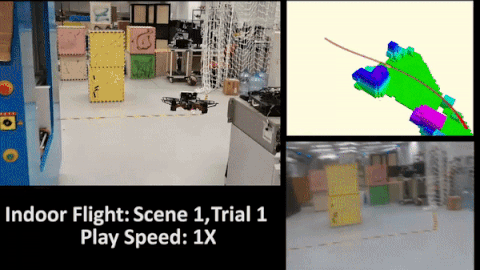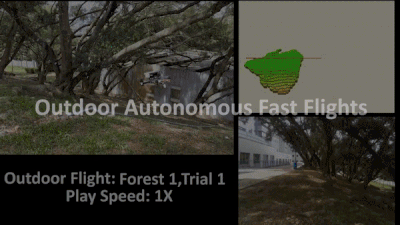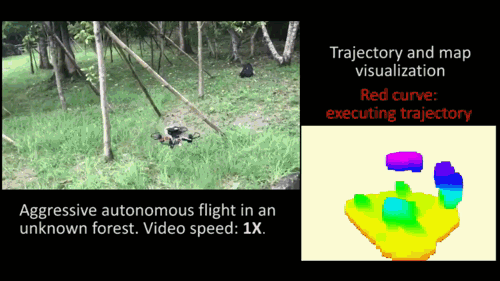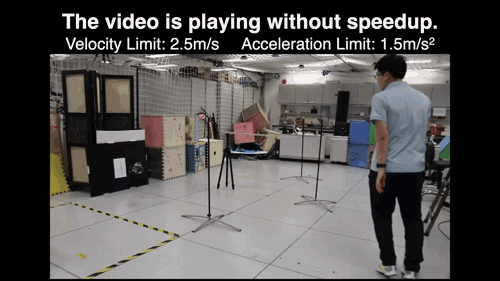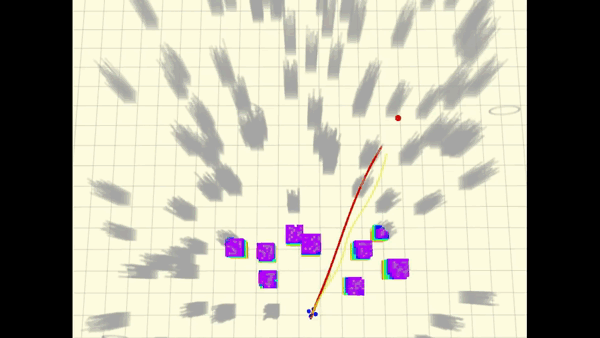Fast-Planner is developed aiming to enable quadrotor fast flight in complex unknown environments. It contains a rich set of carefully designed planning algorithms. More features and interesting methods will come in the future 😉.
Authors: Boyu Zhou and Shaojie Shen from the HUKST Aerial Robotics Group, Fei Gao from ZJU FAST Lab.
Complete videos: video1, video2, video3. Demonstrations about this work have been reported on the IEEE Spectrum: page1, page2, page3 (search for HKUST in the pages).
To run this project in minutes, check Quick Start. Check other sections for more detailed information.
Please kindly star ⭐ this project if it helps you. We take great efforts to develope and maintain it 😁😁.
The project is developed and tested in Ubuntu 16.04, ROS Kinetic. Run the following commands to setup:
sudo apt-get install libnlopt-dev libarmadillo-dev
cd ${YOUR_WORKSPACE_PATH}/src
git clone https://github.com/HKUST-Aerial-Robotics/Fast-Planner.git
cd ../
catkin_make
You may check the detailed instruction to setup the project. After compilation you can start the visualization by:
source devel/setup.bash
roslaunch plan_manage rviz.launch
and start a simulation (run in a new terminals):
source devel/setup.bash
roslaunch plan_manage kino_replan.launch
You will find the random map and the drone in Rviz. You can select goals for the drone to reach using the 2D Nav Goal tool. A sample simulation is showed here.
The project contains a collection of robust and computationally efficient algorithms for quadrotor fast flight:
- Kinodynamic path searching
- B-spline-based trajectory optimization
- Topological path searching and path-guided optimization
- Perception-aware planning strategy (to appear)
These methods are detailed in our papers listed below.
Please cite at least one of our papers if you use this project in your research: Bibtex.
- Robust and Efficient Quadrotor Trajectory Generation for Fast Autonomous Flight, Boyu Zhou, Fei Gao, Luqi Wang, Chuhao Liu and Shaojie Shen, IEEE Robotics and Automation Letters (RA-L), 2019.
- Robust Real-time UAV Replanning Using Guided Gradient-based Optimization and Topological Paths, Boyu Zhou, Fei Gao, Jie Pan and Shaojie Shen, IEEE International Conference on Robotics and Automation (ICRA), 2020.
- RAPTOR: Robust and Perception-aware Trajectory Replanning for Quadrotor Fast Flight, Boyu Zhou, Jie Pan, Fei Gao and Shaojie Shen, submitted to IEEE Transactions on Robotics (T-RO), under review.
All planning algorithms along with other key modules, such as mapping, are implemented in fast_planner:
- plan_env: The online mapping algorithms. It takes in depth image (or point cloud) and camera pose (odometry) pairs as input, do raycasting to update a probabilistic volumetric map, and build an Euclidean signed distance filed (ESDF) for the planning system.
- path_searching: Front-end path searching algorithms. Currently it includes a kinodynamic path searching that respects the dynamics of quadrotors. It also contains a sampling-based topological path searching algorithm to generate multiple topologically distinctive paths that capture the structure of the 3D environments.
- bspline: A implementation of the B-spline-based trajectory representation.
- bspline_opt: The gradient-based trajectory optimization using B-spline trajectory.
- active_perception: Perception-aware planning strategy, which enable to quadrotor to actively observe and avoid unknown obstacles, to appear in the future.
- plan_manage: High-level modules that schedule and call the mapping and planning algorithms. Interfaces for launching the whole system, as well as the configuration files are contained here.
Besides the folder fast_planner, a lightweight uav_simulator is used for testing.
- We use NLopt to solve the non-linear optimization problem. The uav_simulator depends on the C++ linear algebra library Armadillo. The two dependencies can be installed by
sudo apt-get install libnlopt-dev libarmadillo-dev
- Our software is developed and tested in Ubuntu 16.04, ROS Kinetic. Follow the document to install ROS.
After the prerequisites are satisfied, you can clone this repository to your catkin workspace and catkin_make. A new workspace is recommended:
cd ${YOUR_WORKSPACE_PATH}/src
git clone https://github.com/HKUST-Aerial-Robotics/Fast-Planner.git
cd ../
catkin_make
If you encounter problems in this step, most probably caused by different versions of ROS/Eigen, please first refer to existing issues, pull requests and Google before raising a new issue.
Now you are ready to run a simulation.
This step is not mandatory for running the simulations. However, if you want to run the more realistic depth camera in uav_simulator, installation of CUDA Toolkit is needed. Otherwise, a less realistic depth sensor model will be used.
The local_sensing package in uav_simulator has the option of using GPU or CPU to render the depth sensor measurement. By default, it is set to CPU version in CMakeLists:
set(ENABLE_CUDA false)
# set(ENABLE_CUDA true)
However, we STRONGLY recommend the GPU version, because it generates depth images more like a real depth camera. To enable the GPU depth rendering, set ENABLE_CUDA to true, and also remember to change the 'arch' and 'code' flags according to your graphics card devices. You can check the right code here.
set(CUDA_NVCC_FLAGS
-gencode arch=compute_61,code=sm_61;
)
For installation of CUDA, please go to CUDA ToolKit
Run Rviz with our configuration firstly:
<!-- go to your workspace and run: -->
source devel/setup.bash
roslaunch plan_manage rviz.launch
Then run the quadrotor simulator and Fast-Planner. Several examples are provided below:
In this method, a kinodynamic path searching finds a safe, dynamically feasible, and minimum-time initial trajectory in the discretized control space. Then the smoothness and clearance of the trajectory are improved by a B-spline optimization. To test this method, run:
<!-- open a new terminal, go to your workspace and run: -->
source devel/setup.bash
roslaunch plan_manage kino_replan.launch
Normally, you will find the randomly generated map and the drone model in Rviz. At this time, you can trigger the planner using the 2D Nav Goal tool. When a point is clicked in Rviz, a new trajectory will be generated immediately and executed by the drone. A sample is displayed below:
Related algorithms are detailed in this paper.
This method features searching for multiple trajectories in distinctive topological classes. Thanks to the strategy, the solution space is explored more thoroughly, avoiding local minima and yielding better solutions. Similarly, run:
<!-- open a new terminal, go to your workspace and run: -->
source devel/setup.bash
roslaunch plan_manage topo_replan.launch
then you will find the random map generated and can use the 2D Nav Goal to trigger the planner:
Related algorithms are detailed in this paper.
The code will be released after the publication of associated paper.
If you have successfully run the simulation and want to use Fast-Planner in your project, please explore the files kino_replan.launch or topo_replan.launch. Important parameters that may be changed in your usage are contained and documented.
Note that in our configuration, the size of depth image is 640x480. For higher map fusion efficiency we do downsampling (in kino_algorithm.xml, skip_pixel = 2). If you use depth images with lower resolution (like 256x144), you might disable the downsampling by setting skip_pixel = 1. Also, the depth_scaling_factor is set to 1000, which may need to be changed according to your device.
Finally, for setup problem, like compilation error caused by different versions of ROS/Eigen, please first refer to existing issues, pull request, and Google before raising a new issue. Insignificant issue will receive no reply.
-
July 5, 2020: We will release the implementation of paper: RAPTOR: Robust and Perception-aware Trajectory Replanning for Quadrotor Fast Flight (submitted to TRO, under review) in the future.
-
April 12, 2020: The implementation of the ICRA2020 paper: Robust Real-time UAV Replanning Using Guided Gradient-based Optimization and Topological Paths is available.
-
Jan 30, 2020: The volumetric mapping is integrated with our planner. It takes in depth image and camera pose pairs as input, do raycasting to fuse the measurements, and build a Euclidean signed distance field (ESDF) for the planning module.
We use NLopt for non-linear optimization.
The source code is released under GPLv3 license.
This is research code, it is distributed in the hope that it will be useful, but WITHOUT ANY WARRANTY; without even the implied warranty of merchantability or fitness for a particular purpose.
